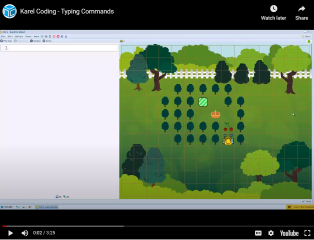

We were, however, soon able to get a version of Karel up and running in the Thetis interpreter we were using at the time.
#Karel the robot program simulator#
In the middle of the 1990s, the simulator we had been using for Karel the Robot stopped working. Many generations of CS106A students learned how programming works by putting Karel through its paces. Karel was used in introductory computer science courses all across the country, to the point that Rich’s textbook sold well over 100,000 copies. (Rossum’ s Universal Robots) gave the word robot to the English language.

That robot was named Karel, after the Czech playwright Karel Capek, whose 1923 play R.U.R. Drawing inspiration from the success of Seymour Papert’s LOGO project at MIT, Rich designed an introductory programming environment in which students teach a robot to solve simple problems.
#Karel the robot program free#
* Unfortunately so far.In the 1970s, a Stanford graduate student named Rich Pattis decided that it would be easier to teach the fundamentals of programming if students could somehow learn the basic ideas in a simple environment free from the complexities that characterize most programming languages. * Post-condition: alternating beepers, stopping (by turning around)at top row. * Pre-condition: no beepers in world, unknown demensions.

* should make sure that your program works for all of the sample * a checkerboard using beepers, as described in Assignment 1. * When you finish writing it, the CheckerboardKarel class should draw trying to fix my moveToWall statement to account for inability to move a second time? Or should I look elsewhere, more generally at my algorithm? Don't fix it for me. In short I am currently unable to make this work if a given row has a length with an odd number of positions (columns) in it. The error is: Karel simply stops at end of first row with most of my 'fixes' or he runs in circles completing row 1, doing row two and then dropping down to row 1 again. My error (I suspect is in the way I am thinking of my moveToWall statement) occurs when he can't make that second move (which occurs when there are an odd number of columns). I turn him around one more time to stop him at end. My basic algorithm is: move along a row (called moveToWall: move, putBeeper, move & move) then turn up into next row. Anything beyond this must be my created methods from these commands and conditions. Of course I can use if, else, for, and, or & while statements. In this situation karel has an infintate number of 'beepers'. I can detect if my way is clear to the front, left & right, if there are beepers present or not, and which way I am facing. I have a number of conditions available to me as well. They are: move, turnRight, turnLeft, put & pick (up) beebers, turnAround. I am required to only use a few commands available to the stanford.superkarel class. However I just can't get it to run successfully in odd numbered column worlds. Mine runs fine in any world with even numbered columns. look at Assignment 1, problem 3 (if you are interested). As you may know in assignment 1 there is the task of causing Karel to place 'beepers' across a world in a checkerboard pattern.

I am doing the free online class from Stanford CS106A.


 0 kommentar(er)
0 kommentar(er)
